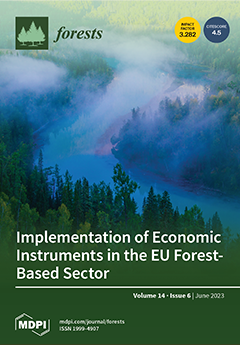Aeolesthes sarta or
Trirachys sarta is a polyphagous long-horned beetle that has caused severe damage to the
Populus alba forests/plantations in its regions of origin. Climate change could accelerate the introduction and spread of invasive pest species, potentially causing ecological damage and economic losses. Furthermore, globalization and increased trade can inadvertently transport pests across borders into regions where they do not already occur. Hence, it is crucial to identify areas where the climate is most suitable for the establishment of
A. sarta’s and which areas of the world are suitable for the growth of
P. alba under climate change scenarios. This study employed the CLIMEX model to estimate the potential global distribution of
A. sarta and its correlation with its dominant host,
P. alba, under current climatic conditions and potential future scenarios, namely the A1B and A2 climate change scenarios (CCSs). Under current climatic conditions, the model indicates that the establishment of a climatically suitable habitat for
A. sarta extends beyond its current known range. The model estimated that, under the world’s current climatic conditions, 41.06% of the world can provide suitable areas (EI > 0) for the survival of
A. sarta. For
P. alba, under the current climatic conditions, suitable regions for the growth of
P. alba are present in all continents (excluding Antarctica); under the world’s current climatic conditions, 53.52% of the world can provide suitable areas for the growth of
P. alba (EI > 0). Climate change will significantly alter the number of suitable habitats for
A. sarta development and
P. alba growth globally. In future climatic conditions, the number areas capable of supplying suitable habitats (EI > 0) for
A. sarta will slightly decrease to 40.14% (under A1B and A2 CCSs), while, for
P. alba, the number areas capable of supplying suitable habitats will also marginally decrease to 50.39% (under A1B scenario), and this figure is estimated to drop to 48.41% (under A2 scenario) by the end century (2100). Asia, Europe, North America, South America, and Oceania have a high percentage of highly suitable areas for
A. sarta development and
P. alba growth under current climatic conditions; however, according to estimates of future climatic conditions, by the end century, only Asia, Europe, North America, and Oceania will have a high percentage of highly suitable areas for
A. sarta development and
P. alba growth. The range of highly suitable habitats is likely to increase in the northern hemisphere; however, this range is expected to shrink with regards to the southern hemisphere. The range contraction was higher under the A2 climate change scenario due to a higher warming trend than in the A1B scenario. Due to climate change, the range of
A. sarta development shifted, as did the
P. alba growth range, which, thanks to the suitable environmental conditions for the growth of
P. alba, makes all those regions vulnerable to the introduction and development of
A. sarta. Strict monitoring, prevention, and control measures at borders, airports, and seaports before the trade of
P. alba and other suitable host species wood (logs/billets) are highly recommended to prevent the spread of
A. sarta and ensure biodiversity security. It is expected that the
A. sarta and
P. alba climate models presented here will be useful for management purposes since both can be adapted to guide decisions about imparting resources to regions where the threat of pest invasion remains and away from regions where climate suitability is predicted to decrease in the future.
Full article





